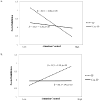The Association Between Infants' Attention Control and Social Inhibition is Moderated by Genetic and Environmental Risk for Anxiety
- PMID: 21857796
- PMCID: PMC3158002
- DOI: 10.1111/j.1532-7078.2011.00068.x
The Association Between Infants' Attention Control and Social Inhibition is Moderated by Genetic and Environmental Risk for Anxiety
Abstract
Infant social inhibition is associated with increased risk for anxiety later in life. Although both genetic and environmental factors are associated with anxiety, little empirical work has addressed how developing regulatory abilities work with genetic and environmental risk to exacerbate or mitigate problem behaviors. The current study was aimed at addressing this gap in research by investigating an early-emerging regulatory behavior, attention control, in association with genetic and environmental risk for anxiety.Participants included 9-month-old adopted infants, their birth mothers, and adoptive parents (n = 361). Lifetime diagnosis of birth mother social phobia was obtained using structured interviews. Adoptive parents completed self-report measures of anxiety symptoms. Infant social inhibition and attention control were coded during a stranger interaction and a barrier task, respectively. Neither adoptive nor birth parent anxiety were directly associated with social inhibition. The association of attention control with social inhibition in infants was moderated by birth and adoptive parent anxiety symptoms. When infants of birth mothers with social phobia were raised by adoptive parents with high self-reported anxiety symptoms, greater attention control was associated with greater social inhibition. However, when raised by adoptive parents with low self-reported anxiety, greater attention control was associated with less social inhibition.
Figures

References
-
- Aiken LS, West SG. Multiple regression: Testing and interpreting interactions. Thousand Oaks, CA: Sage Publications; 1991.
-
- Albano AM, Chorpita BF, Barlow DH. Childhood anxiety disorders. In: Mash EJ, Barkley RA, editors. Child Psychopathology. 2. New York: Guilford Press; 2003. pp. 279–329.
-
- Arcus D, McCartney K. When baby makes four: Family influences in the stability of behavioral inhibition. In: Resnick JS, editor. Perspectives on Behavioral Inhibtion. Chicago: University of Chicago Press; 1989.
-
- Bakermans-Kranenburg MJ, van IJzendoorn MH. Research Review: Genetic vulnerability or differential susceptibility in child development: The case of attachment. Journal of Child Psychology and Psychiatry. 2007;48:1160–173. - PubMed
-
- Bar-Haim Y, Lamy D, Pergamin L, Bakermans-Kranenburg MJ, van IJzendoorn MH. Threat-related attentional bias in anxious and nonanxious individuals: A meta-analytic study. Psychological Bulletin. 2007;133:1–24. - PubMed
Grants and funding
LinkOut - more resources
Full Text Sources
Miscellaneous

